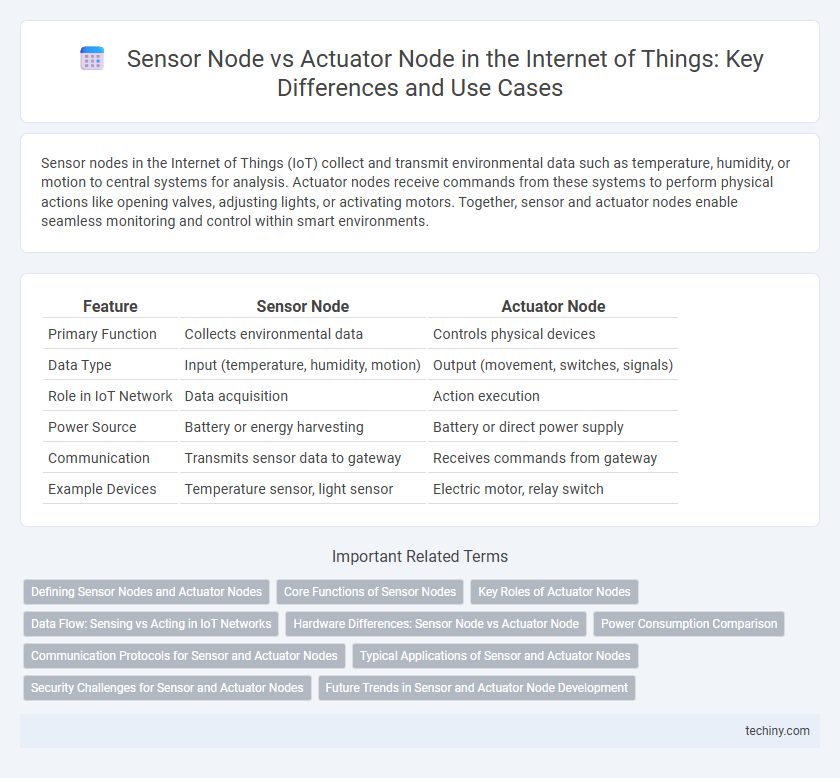Sensor nodes in the Internet of Things (IoT) collect and transmit environmental data such as temperature, humidity, or motion to central systems for analysis. Actuator nodes receive commands from these systems to perform physical actions like opening valves, adjusting lights, or activating motors. Together, sensor and actuator nodes enable seamless monitoring and control within smart environments.
Table of Comparison
| Feature | Sensor Node | Actuator Node |
|---|---|---|
| Primary Function | Collects environmental data | Controls physical devices |
| Data Type | Input (temperature, humidity, motion) | Output (movement, switches, signals) |
| Role in IoT Network | Data acquisition | Action execution |
| Power Source | Battery or energy harvesting | Battery or direct power supply |
| Communication | Transmits sensor data to gateway | Receives commands from gateway |
| Example Devices | Temperature sensor, light sensor | Electric motor, relay switch |
Defining Sensor Nodes and Actuator Nodes
Sensor nodes in the Internet of Things (IoT) are specialized devices designed to detect physical or environmental changes such as temperature, humidity, motion, or light, converting these stimuli into digital signals for monitoring and analysis. Actuator nodes, in contrast, execute commands by manipulating physical systems to control mechanisms like valves, motors, or switches, enabling real-world interactions based on sensor data. Both sensor and actuator nodes form the critical interface between the digital and physical realms, facilitating automated processes and intelligent decision-making within IoT ecosystems.
Core Functions of Sensor Nodes
Sensor nodes in IoT primarily function to detect and collect environmental data such as temperature, humidity, light, or motion through embedded sensors. They process and transmit this information wirelessly to a central system or gateway for analysis. Unlike actuator nodes, sensor nodes do not perform physical actions but provide critical real-time data for informed decision-making in smart environments.
Key Roles of Actuator Nodes
Actuator nodes in the Internet of Things play a critical role by converting digital commands into physical actions, enabling real-world interactions such as opening valves, controlling motors, or adjusting lighting. Unlike sensor nodes that primarily gather and transmit data, actuator nodes execute decisions, facilitating automation and responsive control in smart environments. Their efficient operation is essential for applications like smart homes, industrial automation, and healthcare systems where precise actuation enhances performance and user experience.
Data Flow: Sensing vs Acting in IoT Networks
Sensor nodes in IoT networks primarily focus on data collection by detecting environmental parameters such as temperature, humidity, or motion, converting physical signals into digital data for transmission. Actuator nodes receive processed data commands to perform specific actions like adjusting a thermostat, opening a valve, or activating a motor, thus enabling real-world responses. This distinction highlights the unidirectional sensing data flow from sensor nodes and bidirectional control flow involving actuator nodes within IoT ecosystems.
Hardware Differences: Sensor Node vs Actuator Node
Sensor nodes consist of transducers, signal processors, and wireless communication modules designed to detect environmental parameters such as temperature, humidity, or light intensity. Actuator nodes include control circuitry, power drivers, and mechanical components that execute physical actions like opening valves or switching motors. Sensor nodes prioritize low power consumption and data accuracy, while actuator nodes emphasize robust power handling and precise mechanical control.
Power Consumption Comparison
Sensor nodes in the Internet of Things typically consume less power compared to actuator nodes because sensors primarily gather and transmit data, requiring minimal energy for sensing and communication. Actuator nodes, which perform physical actions based on received commands, demand higher power for driving motors, valves, or other mechanical components, leading to increased energy consumption. Optimizing power consumption in sensor and actuator nodes is critical for extending the battery life and enhancing the sustainability of IoT deployments.
Communication Protocols for Sensor and Actuator Nodes
Sensor nodes predominantly utilize low-power communication protocols such as Zigbee, Bluetooth Low Energy (BLE), and LoRaWAN to efficiently transmit data to central hubs. Actuator nodes often rely on real-time, reliable protocols like MQTT, CoAP, and OPC UA to receive commands and execute actions promptly. Understanding the specific communication protocol requirements of sensor and actuator nodes is essential for optimizing Internet of Things (IoT) network performance and ensuring seamless interoperability.
Typical Applications of Sensor and Actuator Nodes
Sensor nodes in the Internet of Things (IoT) typically monitor environmental conditions such as temperature, humidity, and motion for applications in smart agriculture, industrial automation, and healthcare monitoring. Actuator nodes execute control actions based on sensor data, enabling functionalities like adjusting HVAC systems, controlling robotic arms in manufacturing, and managing smart lighting in buildings. Both sensor and actuator nodes are integral in creating responsive and automated IoT ecosystems across various industries.
Security Challenges for Sensor and Actuator Nodes
Sensor nodes in Internet of Things (IoT) networks face security challenges such as data integrity, authentication vulnerabilities, and battery constraints that limit robust encryption implementation. Actuator nodes confront risks including unauthorized command injection, physical tampering, and real-time response manipulation, which can lead to critical system malfunctions. Both nodes require tailored security protocols to ensure confidentiality, availability, and integrity, protecting against targeted cyber-attacks within IoT infrastructures.
Future Trends in Sensor and Actuator Node Development
Future trends in sensor and actuator node development emphasize enhanced energy efficiency, miniaturization, and integration with AI for improved decision-making capabilities in Internet of Things (IoT) systems. Advanced low-power wireless communication technologies and edge computing enable real-time data processing and autonomous operations within sensor and actuator nodes. The convergence of smart materials and self-healing technologies promises increased durability and adaptability, transforming the functionality of sensor and actuator nodes in dynamic IoT environments.
Sensor Node vs Actuator Node Infographic

 techiny.com
techiny.com